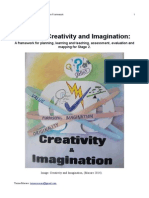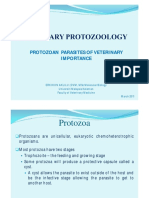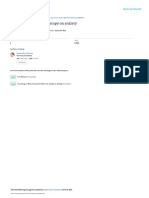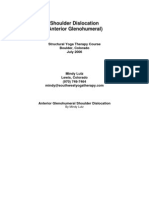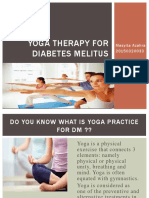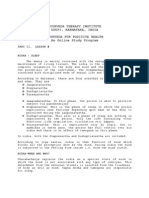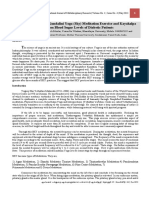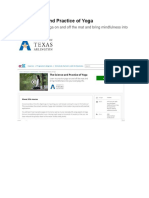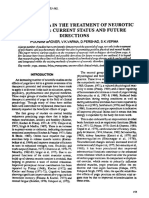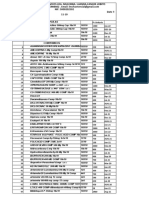Yoga For Palliative Care
Yoga For Palliative Care
Uploaded by
Merce MufaCopyright:
Available Formats
Yoga For Palliative Care
Yoga For Palliative Care
Uploaded by
Merce MufaOriginal Description:
Original Title
Copyright
Available Formats
Share this document
Did you find this document useful?
Is this content inappropriate?
Copyright:
Available Formats
Yoga For Palliative Care
Yoga For Palliative Care
Uploaded by
Merce MufaCopyright:
Available Formats
YOGA FOR PALLIATIVE PATIENTS by
Mercedes Murcia Fanega
WESTERN PERSPECTIVE
Palliative care is an approach that improves the quality of
life of patients and their families facing the problem
associated with life-threatening illness, through the
prevention and relief of suffering by means of early
identification and impeccable assessment and treatment
of pain and other problems, physical, psychosocial and
spiritual. Palliative care:
Provides relief from pain and other distressing
symptoms;
Affirms life and regards dying as a normal process;
Intends neither to hasten or postpone death;
Integrates the psychological and spiritual aspects of
patient care;
Offers a support system to help patients live as
actively as possible until death;
Offers a support system to help the family cope
during the patients illness and in their own
bereavement;
Uses a team approach to address the needs of
patients and their families, including bereavement
counselling, if indicated;
Will enhance quality of life, and may also positively
influence the course of illness;
Is applicable early in the course of illness, in
conjunction with other therapies that are intended to
prolong life, such as chemotherapy or radiation
therapy, and includes those investigations needed to
better understand and manage distressing clinical
complications.
The goal of palliative care in the western perspective is to
achieve the best quality of life for patients and their
families, and to provide a support system to help patients
live as actively as possible until death . Ideally, palliative
care is applied early in the course of illness in conjunction
with other therapies intended to prolong life (such as
chemotherapy or radiation therapy), and investigation and
management of distressing clinical complications (NCHPSCS
2002; DH 2000). Conventional treatments used in palliative
care include drugs such as opioids, NSAIDs, antiemetics,
corticosteroids, tranquillisers and laxatives; radio- and
chemotherapy; and surgery. People may be cared for in
their own homes, hospices, care homes or hospitals.
AYURVEDIC PERSPECTIVE
While approaching death, the process of destruction is
initiated in the body. Functions of various limbs and organs
of the body get disturbed. drainage of strength from
limbs, cessation of movement, destruction of
sensory/tactile, impairment of consciousness, restlessness
in the mind, affliction of the mind with fear, deprivation of
memory and intellect. radical change in the
conduct...wasting of muscle tissue and blood. morbid
changes in the smell of the body...discoloration of the body,
dryness in the orifices of the body.
The process of dying is neither controlled nor precise. This
can be a challenge for pitta individuals who can be over
controlling and demanding, especially in times of stress.
Strong-willed people who are used to being leaders and
making things happen find that they have no control over
the dying process, and this is difficult for pitta. Sometimes
pitta patients and/or family members are very direct and
intense, and communicate in a way that is explosive and
sharp due to their feelings of helplessness and
powerlessness. Strategies to support pitta patients and
families in the dying process include cooling, relaxing and
stress diffusing forms of aromatherapy, breathing practices,
yoga nidra and guided meditation.
When working with kapha individuals in the death and dying
journey, it is important to understand that they may
experience a longer grieving process. Watery emotions such
as tears may be present. Kaphas can also internalize
emotions and not show them, even though they feel very
deeply. Honouring relationships is very important, as is selfcare for caregivers and families who have created deep
attachments to individuals who have passed on.
So from an Ayurvedic perspective we have to treat the
palliative patient focusing in his body type to understand
how he is living the process.
TCM PERSPECTIVE
The goal to treat palliative patients from the TCM
perspective is to make less painful and stressful the end of
the patient life using different kind of treatments like
acupuncture, diet, and naturopathy
TCM may relieve pain in palliative settings and in addition it
may reduce the need for cancer pain drugs. One recent
systematic review found evidence that acupuncture may
provide long-term pain relief in patients with and the most
recent trials have strengthened the evidence.
Pain arising indirectly from cancer treatments may also be
addressed with acupuncture, for example for
chemotherapy- induced neuropathy. Patients with HIVassociated neuropathic pain may also benefit. Filshie
reported that pain from cancer treatments is likely to
respond better, and for longer, that that from the disease
itself; nevertheless, there are still benefits possible for
patients with late-stage cancer.
THINGS THAT WE ARE NOT TO OFFER TO THIS KIND
OF PATIENTS
We are not to offer in our program:
1) Strong practices.
2) Technical and complicate asana practices.
3) Massage and hands on (alignment or massage
relaxation).
4) Very active pranayamas.
TOOLS THAT WE CAN USE
Chanting.
Sharing circles.
Outdoor activities.
Group activities.
One to one classes.
Meditation / Yoga Nidra / Tantra meditation
Gentle asanas.
Painting / Writing / Cooking.
THE SESSION CAN CONSIST ON:
- Guided meditation to empower their calm and
happiness,
- Gentle asana to keep the mobility of their joints and
help the blood circulation and water retention improve.
- Guide them to make to themselves massages to
support their love for themselves and their
independency,
- We can offer classes also with the family to help the
connection and the communication between them.
CHALLENGES THAT CAN APPEAR TO THAT KIND OF
PATIENTS IN THEIR DAILY LIFE AND HOW TO CONNECT
WITH THE 5 ELEMENTS.
We can try to focus our classes or sessions trying to
empower the earth element to make the patients feel
grounded and supporting for us and try to help them to find
their calm and stability. Also could be helpful work with the
water element to try to unblock the hidden emotions and let
them to express their emotions.
- Treat the patients normally, they need to feel normal
and not feel like ill people all the time.
- Talk with the illness in the most normal way to let them
express themselves.
- Dont create false expectations or support fantasies,
be kind but also honest at the same time with them.
You might also like
- Yoga For Cancer: DR R Nagarathna MD, FRCP (Edin) Medical Director Swami Vivekananda Yoga Anusndhana SamsthanaDocument34 pagesYoga For Cancer: DR R Nagarathna MD, FRCP (Edin) Medical Director Swami Vivekananda Yoga Anusndhana SamsthanaAnonymous DgAZYkmQfNo ratings yet
- The Yoga of HealingDocument41 pagesThe Yoga of Healingsillyminds100% (1)
- Kundalini - Yoga For Health and Healing XXX PDFDocument148 pagesKundalini - Yoga For Health and Healing XXX PDFMerce Mufa100% (1)
- CHAKRAS and Endocrine GlandDocument7 pagesCHAKRAS and Endocrine GlandMerce MufaNo ratings yet
- CXC Human and Social Biology Past Paper 1 2006Document22 pagesCXC Human and Social Biology Past Paper 1 2006enitsirkellenajNo ratings yet
- Terina Macare Embrace Creativity and Imagination FrameworkDocument20 pagesTerina Macare Embrace Creativity and Imagination Frameworkapi-266593657No ratings yet
- Veterinary ProtozoologyDocument43 pagesVeterinary Protozoologywarda100% (1)
- Yoga and Menopausal TransitionDocument3 pagesYoga and Menopausal TransitionTejaNo ratings yet
- Yoga School of Thought and Psychiatry: Therapeutic PotentialDocument5 pagesYoga School of Thought and Psychiatry: Therapeutic PotentialKersaspNalladaruNo ratings yet
- Yoga & ObesityDocument194 pagesYoga & ObesitydrmadankumarbnysNo ratings yet
- The Benefits of Yoga Therapy For Heart Failure PatientsDocument96 pagesThe Benefits of Yoga Therapy For Heart Failure PatientsAlexandru MagdalenNo ratings yet
- Yoga: The Original Mind Body MedicineDocument5 pagesYoga: The Original Mind Body MedicineMARCO GUTZNo ratings yet
- Yoga Guidelines PDFDocument3 pagesYoga Guidelines PDFConstell LaboratoryNo ratings yet
- The Influence of Yoga Therapy On AnxietyDocument9 pagesThe Influence of Yoga Therapy On AnxietypronitNo ratings yet
- Shoulder Dislocation - Mindy LutzDocument17 pagesShoulder Dislocation - Mindy LutzpritammotghareNo ratings yet
- Yoga de Stress ProgrammDocument6 pagesYoga de Stress ProgrammSnikitaNo ratings yet
- hw499 Unit 5 AssignmentDocument15 pageshw499 Unit 5 Assignmentapi-464950691100% (1)
- Prep Poses For Frog - Yoga JournalDocument5 pagesPrep Poses For Frog - Yoga JournalMichela Brígida RodriguesNo ratings yet
- Male Reproductive Health and Yoga Sengupta P, Chaudhuri P, Bhattacharya K - Int J YogaDocument8 pagesMale Reproductive Health and Yoga Sengupta P, Chaudhuri P, Bhattacharya K - Int J YogamilindNo ratings yet
- Yoga TherapyDocument3 pagesYoga Therapyvvk639228100% (1)
- Yoga For FertilityDocument7 pagesYoga For Fertilitykey yogaNo ratings yet
- Parkinson Treatment ExercisesDocument42 pagesParkinson Treatment Exercisesn&t3000No ratings yet
- YogaDocument8 pagesYogaamrulloh qusyainyNo ratings yet
- Therapeutic Benefits of Yogas PranayamasDocument12 pagesTherapeutic Benefits of Yogas Pranayamaspsi.cynthiavianaNo ratings yet
- Osteo Arthritis-Thesis ProposalDocument15 pagesOsteo Arthritis-Thesis Proposalrasikaa67% (3)
- HypopressivesDocument17 pagesHypopressivesBreylin CastilloNo ratings yet
- Nidra - SleepDocument15 pagesNidra - SleepSreedhar RaoNo ratings yet
- Yoga & HypothyroidismDocument6 pagesYoga & Hypothyroidismtttt45No ratings yet
- Yoga e Pilates para Gravidas PDFDocument41 pagesYoga e Pilates para Gravidas PDFalmaformaNo ratings yet
- Yoga: Mudras For PranayamaDocument4 pagesYoga: Mudras For PranayamaZoltan VasaNo ratings yet
- Yoga Fiction: Yoga Truth, Ebook 2: Flowing Prana, Sparks Your Creative VolitionFrom EverandYoga Fiction: Yoga Truth, Ebook 2: Flowing Prana, Sparks Your Creative VolitionNo ratings yet
- Palliative Care Credit BoonthidaDocument22 pagesPalliative Care Credit BoonthidaKasamapon Oak ChawanachitNo ratings yet
- Yoga Therapy: Anam Riaz Lahore, PakistanDocument1 pageYoga Therapy: Anam Riaz Lahore, PakistanamirNo ratings yet
- Ayurvedic Management of SciaticaDocument7 pagesAyurvedic Management of SciaticaSummit GautamNo ratings yet
- Svastha Yoga of Krishnamacharya: Therapy ProgramDocument7 pagesSvastha Yoga of Krishnamacharya: Therapy ProgramUwe HeimNo ratings yet
- Smith, K. B. & Pukall, C. F. (2009) - An Evidence-Based Review of Yoga As A Complementary Intervention For Patients With CancerDocument12 pagesSmith, K. B. & Pukall, C. F. (2009) - An Evidence-Based Review of Yoga As A Complementary Intervention For Patients With CancerDerly ObtialNo ratings yet
- Asana PDFDocument25 pagesAsana PDFGerardo Ingram100% (1)
- Effect of Sky Yoga On Blood Sugar Levels of Diabetic PatientsDocument8 pagesEffect of Sky Yoga On Blood Sugar Levels of Diabetic PatientsGopal KrishnanNo ratings yet
- Yoga For Better HealthDocument39 pagesYoga For Better HealthCservenák GáborNo ratings yet
- ParkinsonDocument10 pagesParkinson46238148No ratings yet
- Admission Brochure of CCYPIDocument40 pagesAdmission Brochure of CCYPIRavin ChetalNo ratings yet
- CYTER Report - Sept2014Document209 pagesCYTER Report - Sept2014Yogacharya Dr Ananda Balayogi Bhavanani100% (1)
- BandhasDocument1 pageBandhassujasundarNo ratings yet
- Yoga and TherapyDocument5 pagesYoga and TherapymargaritassNo ratings yet
- Yoga For Anxiety and HypertensionDocument2 pagesYoga For Anxiety and HypertensionnawazdakhveNo ratings yet
- Empowered Aging: Everyday Yoga Practices for Bone Health, Strength and BalanceFrom EverandEmpowered Aging: Everyday Yoga Practices for Bone Health, Strength and BalanceNo ratings yet
- Yoga Course by SR at KanpurDocument14 pagesYoga Course by SR at KanpurswamiramaNo ratings yet
- Yoga TherapyDocument95 pagesYoga Therapysivaprasth_vNo ratings yet
- Art of Living ReadyDocument14 pagesArt of Living Readysehaj0150% (2)
- Dinacharya PDFDocument3 pagesDinacharya PDFKrishnaswamy JajimoggalaNo ratings yet
- The Science and Practice of Yoga - UTArlingtonXDocument8 pagesThe Science and Practice of Yoga - UTArlingtonXSorinel BalanNo ratings yet
- AyurvedaDocument20 pagesAyurvedaramdas2430No ratings yet
- Yoga Retreat in India - Short Course - Yoga Treatment - Yoga TherapyDocument1 pageYoga Retreat in India - Short Course - Yoga Treatment - Yoga TherapynaveenNo ratings yet
- Yoga in The Treatment of Neurotic Disorders PDFDocument10 pagesYoga in The Treatment of Neurotic Disorders PDFDejana AnaNo ratings yet
- The Integrated Approach of Yoga Therapy For Good LifeDocument9 pagesThe Integrated Approach of Yoga Therapy For Good LifeChandra BalaNo ratings yet
- Yoga and Positive Mental HealthDocument8 pagesYoga and Positive Mental HealthAnthony McIvorNo ratings yet
- AyurvedaDocument32 pagesAyurvedaRajeswari RanganathanNo ratings yet
- Benefits of Meditation and ConclusionDocument3 pagesBenefits of Meditation and Conclusion2285 Rishika VaidyaNo ratings yet
- Medicinal Therapies in Veda: Review ArticleDocument6 pagesMedicinal Therapies in Veda: Review ArticleMaheswaran R100% (1)
- Earth & WaterDocument64 pagesEarth & WaterMerce MufaNo ratings yet
- MUDRASDocument25 pagesMUDRASMerce MufaNo ratings yet
- Chart of Common Physical Ailments and Their Possible Chakra OrientationDocument15 pagesChart of Common Physical Ailments and Their Possible Chakra OrientationMerce MufaNo ratings yet
- Chakra Healing CourseDocument35 pagesChakra Healing CourseMerce Mufa92% (13)
- Kundalini BasicsDocument17 pagesKundalini Basicsavatar1959100% (9)
- HTF211 Report - Food FlowDocument30 pagesHTF211 Report - Food FlowNur AmyliaNo ratings yet
- Indian Medicines Price 5-11Document5 pagesIndian Medicines Price 5-11Douctor Armando Dos SantosNo ratings yet
- Ralli International School SESSION: 2022-23 Subject: English Class: Viii Sample Question PaperDocument6 pagesRalli International School SESSION: 2022-23 Subject: English Class: Viii Sample Question PaperManyata AroraNo ratings yet
- Fundamentals of Nursing Exam 1Document11 pagesFundamentals of Nursing Exam 1Beverly DatuNo ratings yet
- 3.arma &pterygiumDocument23 pages3.arma &pterygiumPreeti PatelNo ratings yet
- Mathematics Ra Professional Teacher Legazpi 3-2024Document28 pagesMathematics Ra Professional Teacher Legazpi 3-2024Ma. Catherine PaternoNo ratings yet
- Effects of 10 Months of Speed Functional And.94254Document11 pagesEffects of 10 Months of Speed Functional And.94254Eduardo SussNo ratings yet
- Buildingthebeast PDFDocument64 pagesBuildingthebeast PDFJohnnie100% (3)
- Bone Fracture Grp3Document12 pagesBone Fracture Grp3Marjian BaruaNo ratings yet
- A Manual For Psychologists PDFDocument162 pagesA Manual For Psychologists PDFJona Addatu100% (2)
- Ionized Vs Total CalciumDocument3 pagesIonized Vs Total Calciumshaun tanNo ratings yet
- Group Plan Member Change FormDocument4 pagesGroup Plan Member Change FormPooja BatraNo ratings yet
- Cindy Lost YouthDocument1 pageCindy Lost Youthapi-375910410No ratings yet
- ColgateDocument12 pagesColgateHimesh ReshamiaNo ratings yet
- Inclusion of Ivermectin in The First Therapeutic Line of Action For Covid-19Document9 pagesInclusion of Ivermectin in The First Therapeutic Line of Action For Covid-19kavaronNo ratings yet
- Effect of Early Physical Therapy Interventions On Post-Operative Ileus Following Abdominal HysterectomyDocument4 pagesEffect of Early Physical Therapy Interventions On Post-Operative Ileus Following Abdominal HysterectomyririnNo ratings yet
- Spurwink Report of Mila's Sex Abuse Report 3Document4 pagesSpurwink Report of Mila's Sex Abuse Report 3Lori HandrahanNo ratings yet
- CIPLADocument28 pagesCIPLABhakti ShindeNo ratings yet
- Today Admissions Discharge FON Sem-1 2021Document25 pagesToday Admissions Discharge FON Sem-1 2021zakiralihussaini786No ratings yet
- States of ConsciousnessDocument71 pagesStates of ConsciousnesskatNo ratings yet
- Managing Change: Jean B. Ganub, RPHDocument15 pagesManaging Change: Jean B. Ganub, RPHJean GanubNo ratings yet
- Acute AbdomenDocument29 pagesAcute AbdomenUmar AzlanNo ratings yet
- HALLUCINATIONDocument40 pagesHALLUCINATIONHitakshi GhoshNo ratings yet
- NauseaDocument12 pagesNauseakazakom100% (2)
- Bipartisan Congressional Task Force On Economic Growth in Puerto Rico Releases Final Report PDFDocument125 pagesBipartisan Congressional Task Force On Economic Growth in Puerto Rico Releases Final Report PDFLu Ja Beltrán-ÁlvarezNo ratings yet
- Biostatistics / Orthodontic Courses by Indian Dental AcademyDocument45 pagesBiostatistics / Orthodontic Courses by Indian Dental Academyindian dental academy100% (1)
- #9 - PoliticsDocument22 pages#9 - Politicswhat white elephantNo ratings yet





